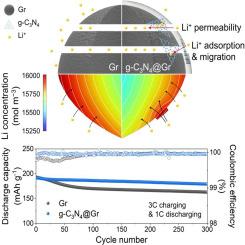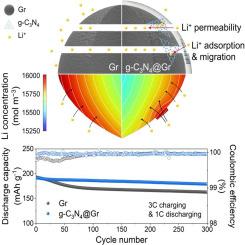通过g-C3N4表面工程减轻石墨阳极的快速充电限制
IF 20.2
1区 材料科学
Q1 CHEMISTRY, PHYSICAL
引用次数: 0
摘要
随着电动汽车(EV)市场的迅速扩大,为了延长行驶里程和缩短充电时间,对快速充电锂离子电池(lib)的需求大幅增加。然而,在快速充电条件下,商用石墨(Gr)阳极的界面动力学缓慢,最终导致其表面镀锂,从而导致严重的容量损失和安全问题。本文介绍了一种使用石墨氮化碳(g-C3N4)修饰Gr阳极的表面工程方法。粒子和电极水平的三维电化学建模已经确定了有效提高快速充电能力的功能性表面涂层的关键要求。通过简单的化学剥离和后处理,g-C3N4纳米片在Gr颗粒上形成功能表面层,降低了充电过程中Li⁺吸附和迁移的活化能。因此,g- c3n4修饰的Gr (g-C3N4@Gr)具有较低的过电位,可以有效抑制快速充电条件下的锂电镀。当在全电池配置中与商用LiNi0.8Co0.1Mn0.1O2阴极配对时,g-C3N4@Gr阳极显示出高达300次循环的稳定循环性能,仅在6.8分钟内实现80%的充电状态。本研究清晰地描述了商用Gr阳极的快速充电机理,并提出了推进快速充电LIB技术的实用策略。本文章由计算机程序翻译,如有差异,请以英文原文为准。


Mitigating the fast-charging limitations of graphite anodes via g-C3N4 surface engineering
With the rapid expansion of the electric vehicle (EV) market, the demand for fast-charging lithium-ion batteries (LIBs) has increased considerably to extend the driving range and reduce charging time. However, commercial graphite (Gr) anodes suffer from slow interfacial kinetics under fast-charging conditions, ultimately causing Li plating on their surfaces, which results in significant capacity losses and safety concerns. Herein, a surface engineering approach using graphitic carbon nitride (g-C3N4) is introduced to modify Gr anodes. Three-dimensional electrochemical modeling at particle- and electrode-levels has identified critical requirements for functional surface coatings that effectively improve the fast-charging capability. By conducting a simple chemical exfoliation process followed by a post-heat treatment, g-C3N4 nanoplates form a functional surface layer on Gr particles, which reduces the activation energy for Li⁺ adsorption and migration during charging. Hence, g-C3N4-decorated Gr (g-C3N4@Gr) exhibits a lower overpotential and effectively suppresses Li plating under fast-charging conditions. When paired with a commercial LiNi0.8Co0.1Mn0.1O2 cathode in a full-cell configuration, the g-C3N4@Gr anode demonstrates stable cycling performance for up to 300 cycles, achieving an 80 % state of charge in only 6.8 min. This study clearly describes the fast-charging mechanism in commercial Gr anodes and a practical strategy for advancing fast-charging LIB technology.
求助全文
通过发布文献求助,成功后即可免费获取论文全文。
去求助
来源期刊

Energy Storage Materials
Materials Science-General Materials Science
CiteScore
33.00
自引率
5.90%
发文量
652
审稿时长
27 days
期刊介绍:
Energy Storage Materials is a global interdisciplinary journal dedicated to sharing scientific and technological advancements in materials and devices for advanced energy storage and related energy conversion, such as in metal-O2 batteries. The journal features comprehensive research articles, including full papers and short communications, as well as authoritative feature articles and reviews by leading experts in the field.
Energy Storage Materials covers a wide range of topics, including the synthesis, fabrication, structure, properties, performance, and technological applications of energy storage materials. Additionally, the journal explores strategies, policies, and developments in the field of energy storage materials and devices for sustainable energy.
Published papers are selected based on their scientific and technological significance, their ability to provide valuable new knowledge, and their relevance to the international research community.
 求助内容:
求助内容: 应助结果提醒方式:
应助结果提醒方式:


